

Security implications of public vs. private clouds. It never fails.

People are fascinated by the cloud. Whether it's my doctor trying to get a free consultation on making health care IT choices (while at the same time, charging me $150 to tap my knee with a hammer) or the local car dealer trying to optimize repair scheduling (while at the same time, trying to charge me extra for floor mats), everyone is interested in the cloud. Once you get past the idea that the cloud isn't a place full of soft, fuzzy foam, but is a wide array of really huge datacenters with thousands of servers and a power load to rival a small city, cloud concepts start confusing people. Nothing, it seems, is more confusing than the difference between public and private clouds, and beyond that, the safety and security implications of using either type of service. So in this article, I'll run through some of the basics. The cloud datacenter environment Let's first take a second and describe what a cloud datacenter environment is.
Public vs. private cloud What I do. Thinking About the Cloud and Saas? Here’s What You Need to Know. Thinking of heading to the cloud in 2012?
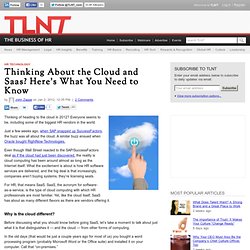
Everyone seems to be, including some of the biggest HR vendors in the world. Just a few weeks ago, when SAP snapped up SuccessFactors, the buzz was all about the cloud. A similar buzz ensued when Oracle bought RightNow Technologies. Top cloud IaaS providers compared. Thoran Rodrigues updates his comparison of some of the top IaaS providers, including categories of cost, scalability, ease of migration, reliability, and security.
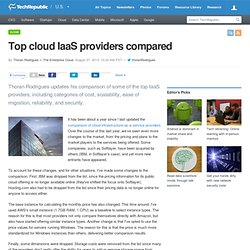
It has been about a year since I last updated the comparison of cloud infrastructure-as-a-service providers. Over the course of this last year, we’ve seen even more changes to the market, from the pricing and plans to the market players to the services being offered. Some companies, such as Softlayer, have been acquired by others (IBM, in Softlayer’s case), and yet more new entrants have appeared. Unveiling Skyhigh’s Comprehensive Data Governance Solution for Salesforce.
Unveiling Skyhigh’s Comprehensive Data Governance Solution for Salesforce Data governance for the cloud is quickly becoming a topic of heated interest.
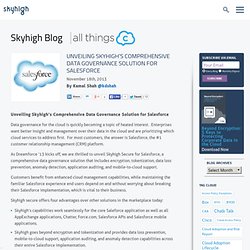
Enterprises want better insight and management over their data in the cloud and are prioritizing which cloud services to address first. For most customers, the answer is Salesforce, the #1 customer relationship management (CRM) platform. As Dreamforce ’13 kicks off, we are thrilled to unveil Skyhigh Secure for Salesforce, a comprehensive data governance solution that includes encryption, tokenization, data loss prevention, anomaly detection, application auditing, and mobile-to-cloud support.
Customers benefit from enhanced cloud management capabilities, while maintaining the familiar Salesforce experience end users depend on and without worrying about breaking their Salesforce implementation, which is vital to their business. Skyhigh secure offers four advantages over other solutions in the marketplace today: Don’t take my word for it. Automating Cloud Security. Verizon's 2013 Data Breach Investigations Report trumpets the fact that security issues are still a major concern for all IT organizations.
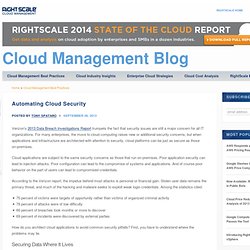
For many enterprises, the move to cloud computing raises new or additional security concerns, but when applications and infrastructure are architected with attention to security, cloud platforms can be just as secure as those on-premises. Cloud applications are subject to the same security concerns as those that run on-premises. Poor application security can lead to injection attacks. Poor configuration can lead to the compromise of systems and applications. And of course poor behavior on the part of users can lead to compromised credentials. According to the Verizon report, the impetus behind most attacks is personal or financial gain. Not all clouds are created equal. Backupify opens up its cloud-to-cloud backup to more SaaS vendors. Backupify, a cloud-based backup service offered for SaaS platforms including Salesforce and Google Apps, may expand to many other SaaS platforms through a developer kit designed for quick and easy integration.
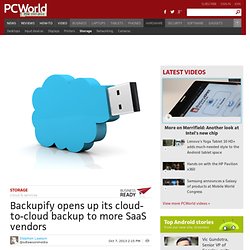
Backupify’s proposition is that two clouds are better than one. Its service, available in the app stores for Salesforce and Google Apps, backs up enterprises’ data from those SaaS (software as a service) platforms in Backupify’s storage bucket on Amazon S3. Each enterprise’s data there is encrypted with a customer-specific key. The service benefits SaaS providers as well as enterprises, said Daniel Stevenson, Backupify’s vice president of business development. “We offer them the ability to provide their customers with an extra layer of data protection,” Stevenson said. There are about 6,000 enterprises using Backupify, and most use it for Salesforce or Google Apps, Stevenson said. The developer platform is already live. Security in a Public IaaS Cloud Part 2: Access to Cloud Servers. September 19, 2010 - 12:07 pm.

Posted by Patrick Baillie Blog Posts In the second part of my series of blog posts on security I will cover the issue of securing access to your cloud server. Unlike with dedicated hardware, cloud servers offer you the ability to remotely conduct infrastructure management and other actions. These very powerful tools make running your cloud infrastructure significantly more convenient than dedicated hardware. Infrastructure-as-a-Service (IaaS) offerings enable more points of access to your cloud infrastructure than dedicated hardware. Physical access to infrastructureAccess via the open internetAccess via the web management consoleAccess via the API The first two share the same characteristics as traditional dedicated hardware, the second two are more associated with cloud infrastructure so I’ll go into those in greater detail. Facing Cyber Security Threats in the Cloud.
Whenever I present at conferences, or even when I’m in a conversation with a CPA or accountant, the number one topic on most everyone’s mind is about cloud security.
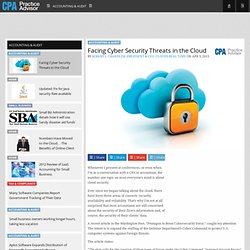
Ever since we began talking about the cloud, there have been three areas of concern: security, availability and reliability. That’s why I’m not at all surprised that most accountants are still concerned about the security of their firm’s information and, of course, the security of their clients’ data. A recent article in the Washington Post, “Pentagon to Boost Cybersecurity Force,” caught my attention. The intent is to expand the staffing of the Defense Department’s Cyber Command to protect U.S. computer systems against foreign threats. The article states: This may sound very “James Bond,” but it still is a very viable and real concern, and I’m glad to hear that our government is bolstering its defenses against other nations that want to see us fail. The new opportunity for PaaS vendors: cloud services curation. The many benefits Platform as a Service (PaaS) bring to the enterprise are well known and well publicized — chief among them the ability for developers to build applications faster than ever before.
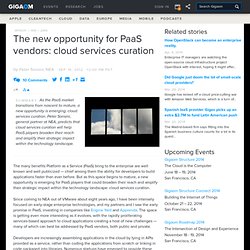
But as this space begins to mature, a new opportunity is emerging for PaaS players that could broaden their reach and amplify their strategic impact within the technology landscape: cloud services curation. Since coming to NEA out of VMware about eight years ago, I have been intensely focused on early-stage enterprise technologies, and my partners and I saw the early promise in PaaS, investing in companies like Engine Yard and Apprenda. The space is getting even more interesting as it evolves, with the rapidly proliferating services-based approach to cloud applications creating a host of new challenges — many of which can best be addressed by PaaS vendors, both public and private. You may ask, what about Amazon? Image courtesy of Flickr user Materials Aart.
CloudControl PaaS add-on for cloud-based image management. More and more developers are getting to know the power of the cloud.
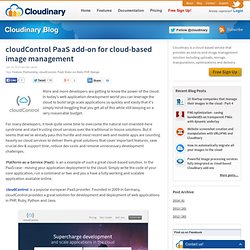
In today's web application development world you can leverage the cloud to build large scale applications so quickly and easily that it's simply mind-boggling that you get all of this while still keeping on a very reasonable budget. For many developers, it took quite some time to overcome the natural not-invented-here syndrome and start trusting cloud services over the traditional in-house solutions. But it seems that we've already pass this hurdle and most recent web and mobile apps are counting heavily on cloud services to deliver them great solutions that cover important features, save crucial dev & support time, reduce dev costs and remove unnecessary development challenges.
Platform-as-a-Service (PaaS) is an a example of such a great cloud-based solution. In the PaaS case - moving your application deployment to the cloud. CloudControl is a popular european PaaS provider.